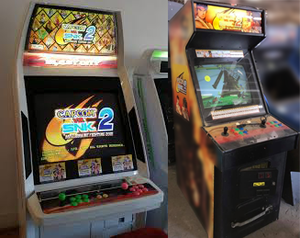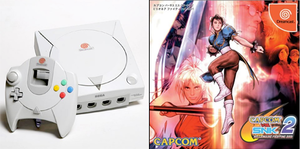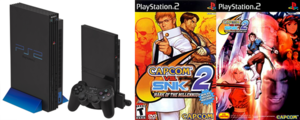m (→Sega Dreamcast) |
m (→Sega Dreamcast) |
||
| Line 45: | Line 45: | ||
Major tournaments will often run the Dreamcast version, usually with an SD card loader mod to skip the need for physical discs and an HDMI mod to output on modern displays without adding input lag (or lugging around heavy CRTs and VGA monitors). Use of modern controllers and USB fight sticks are possible on the Dreamcast via Brook PS3/PS4 to DC controller converters, though vets will prefer native or direct-connection joysticks. | Major tournaments will often run the Dreamcast version, usually with an SD card loader mod to skip the need for physical discs and an HDMI mod to output on modern displays without adding input lag (or lugging around heavy CRTs and VGA monitors). Use of modern controllers and USB fight sticks are possible on the Dreamcast via Brook PS3/PS4 to DC controller converters, though vets will prefer native or direct-connection joysticks. | ||
Note, however, that due to the Dreamcast only having seven buttons—six face buttons and the Start button—there is no room for nor are there in-game options for macro assignment for rolls, activation, etc. There isn't even room for a dedicated Taunt button! (The Start button alone pauses the game. To Taunt in the Dreamcast version, press | Note, however, that due to the Dreamcast only having seven buttons—six face buttons and the Start button—there is no room for nor are there in-game options for macro assignment for rolls, activation, etc. There isn't even room for a dedicated Taunt button! (The Start button alone pauses the game. To Taunt in the Dreamcast version, press {{Icon-Capcom|LK}}+Start.) Keep this in mind if you are coming into an event using Dreamcast (or Arcade) setups, as macro users cannot be accommodated. | ||
== Sony PlayStation 2 == | == Sony PlayStation 2 == | ||
Revision as of 16:17, 8 March 2022
Capcom vs. SNK 2 was released in arcades worldwide on August 3, 2001. It was ported to the Dreamcast and PlayStation 2 a few months later. In Japan, both console versions had online play, complete with DC and PS2 crossplay. In the summer of 2003, an updated version of the game titled Capcom vs. SNK 2 EO was released for the GameCube and Xbox, the latter of which had online play through Xbox Live. Ten years after that, in 2013, the PS2 version was brought to the PlayStation 3 with PS2 Classics download.
From a competitive standpoint, there are important differences between the versions. Generally, we divide them between which versions are suitable to be played at tournaments and which are not. Differences between the Japanese and English versions are insignificant enough to not matter. No knowledge of Japanese is required to play the JP versions since the main game functions, options, and critical text are all in English. Even the legendary CvS2 announcer speaks in English!
The most significant version difference to be aware of is what happened with the GameCube and Xbox versions. Long story short, CvS2EO has enough minor gameplay changes—and one major bug fix—that it is not used in tournaments. This will be explained in further detail below.
If you are just looking to play casually, don't worry about this stuff too much. Just pick the version that is most convenient to you, and play it!
For information on emulation and GGPO rollback netplay of the various CvS2 versions, see the Emulation and Netplay page.
Tournament Standard Versions
NAOMI Arcade
The arcade version of CvS2 running on NAOMI hardware is the definitive and reference version of the game. It is superior to any console port (or emulated version) and always will be.
The main way to play in Japan is still the arcade. CvS2 hotspots in the U.S. will still have NAOMI cabinets running the game, either in arcades, private residences open to the public for game nights, or wherever else super enthusiasts may have them.
Early runs of the arcade version are the most preferred version to play on due to it having a post-KO meter building glitch. This was removed from later arcade builds and the console ports. There is no preference for competitive play between Japanese and English versions, but the single-player arcade mode in the English versions removed the ability to choose win screen dialog between your team members.
You will really want to play the game on an arcade cabinet! They are obviously much harder to find these days, although modern gaming centers like Round 1 are helping them make a comeback. If you're near someone or a place with the arcade version, consider yourself very fortunate. Make sure to support them every chance you get!
Sega Dreamcast
Dreamcast hardware is functionally the same as the hardware that powers the NAOMI arcade board, meaning CvS2 on the Dreamcast is a basically identical to the arcade version and therefore the definitive console version. If you are looking for the most ideal home or tournament setup of CvS2, getting a Dreamcast will be your ultimate goal!
Notably, CvS2 on Dreamcast was only released in Japan. A US release was planned, but it was cancelled due to Sega discontinuing the Dreamcast and exiting the console hardware business altogether in early 2001. As a result, any version of CvS2 played on the Dreamcast can only ever be the Japanese version.
As with all home console ports of the game, several features were added on top of the traditional Arcade Mode:
- Versus Mode with a combined groove/character quick-select screen (both players will need to re-pick characters after every game, that's just how it was Back In The Day);
- 3-on-3 and Single (one character each, 2 out of 3 rounds) modes, in addition to standard Ratio matches, in Arcade and Versus modes;
- A dedicated Training Mode;
- Replay Mode, where you could view and manage replay save files;
- Color Edit Mode, allowing a custom color palette and custom name to be created for each character;
- Groove Edit Mode, which once unlocked allowed for custom EX-Grooves with user-selected meter bars and subsystems;
- Survival Mode, Infinite Survival Mode, and (the secret) Boss Survival Mode;
- Option Mode and (unlockable) Extra Options which could change gameplay elements, make display adjustments, and bring Training Mode features into single player modes.
(The Dreamcast, Japanese PS2, and Xbox versions also included Network Mode, which started online play. As these services have long been discontinued, there is no point in selecting this option; you will just get perpetual errors.)
Major tournaments will often run the Dreamcast version, usually with an SD card loader mod to skip the need for physical discs and an HDMI mod to output on modern displays without adding input lag (or lugging around heavy CRTs and VGA monitors). Use of modern controllers and USB fight sticks are possible on the Dreamcast via Brook PS3/PS4 to DC controller converters, though vets will prefer native or direct-connection joysticks.
Note, however, that due to the Dreamcast only having seven buttons—six face buttons and the Start button—there is no room for nor are there in-game options for macro assignment for rolls, activation, etc. There isn't even room for a dedicated Taunt button! (The Start button alone pauses the game. To Taunt in the Dreamcast version, press ![]() +Start.) Keep this in mind if you are coming into an event using Dreamcast (or Arcade) setups, as macro users cannot be accommodated.
+Start.) Keep this in mind if you are coming into an event using Dreamcast (or Arcade) setups, as macro users cannot be accommodated.
Sony PlayStation 2
The PlayStation 2 version of CvS2 is a solid and completely acceptable port. Although the Dreamcast version of the game is the superior console port, the PS2 version is basically equivalent when it comes to running locals or tournaments. It is also the only tournament-standard version of the game that was released in the U.S. and other English-speaking territories. Although it runs at a slightly faster speed due to the hardware differences, it is not significant enough for most people to notice.
The PS2 version is most common version of CvS2 by a significant margin, which makes sense given how popular the system was. This means the game and hardware is widely available and (thankfully) still relatively cheap to pick up should you want to pursue an offline setup. Brook USB adapters are available for the PS2 if use of modern fight sticks or controllers is desired, but the PS2 also has the most options for native fightsticks or dedicated fight controllers if you want to go that route.
Because it had a controller with many more buttons than the Dreamcast controller, the PS2 version added the ability to map macro commands to buttons. With the six attack buttons, there are two additional assignment slots for the extra two shoulder buttons/triggers. (Taunt has been assigned to the Select button, although the ![]() +Start combo still works.) This means you can assign rolls (
+Start combo still works.) This means you can assign rolls (![]() +
+![]() ), meter activations (
), meter activations (![]() +
+![]() ), or 3P/3K attacks (
), or 3P/3K attacks (![]()
![]()
![]() /
/![]()
![]()
![]() ) to a single button. This is obviously a big convenience to controller users, but it also makes things like Roll Cancelling much easier to do, making the use of macros in PS2 tournaments a touch-and-go subject that is usually down to TO preference.
) to a single button. This is obviously a big convenience to controller users, but it also makes things like Roll Cancelling much easier to do, making the use of macros in PS2 tournaments a touch-and-go subject that is usually down to TO preference.
For the hardcore enthusiasts, you can install CvS2 to an internal hard drive (in the original "fat" PS2 model) via the Free McBoot memory card exploit and Open PS2 Loader. This allows you to carry your games around without the need to swap discs, and of course greatly improves load times. Setting these up goes beyond the scope of this wiki, but is an option you should be aware of.
Sony PlayStation 3: PS2 Backwards Compatibility
.
Non-Standard Versions
.
Sony PlayStation 3: PS2 Classic on PSN
.
Capcom vs. SNK 2 EO
.
Nintendo GameCube
.
Microsoft Xbox
.
Notable US/JPN Region Differences
.


















































